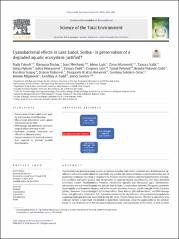| dc.description.abstract | Cyanobacteria are present in many aquatic ecosystems in Serbia. Lake Ludoš, a wetland area of international significance
and an important habitat for waterbirds, has become the subject of intense research interest because of
practically continuous blooming of cyanobacteria. Analyses of water samples indicated a deterioration of ecological
condition and water quality, and the presence of toxin-producing cyanobacteria (the most abundant
Limnothrix redekei, Pseudanabaena limnetica, Planktothrix agardhii and Microcystis spp.). Furthermore,
microcystins were detected in plants and animals from the lake: in macrophyte rhizomes (Phragmites communis,
Typha latifolia and Nymphaea elegans), and in the muscle, intestines, kidneys, gonads and gills of fish (Carassius
gibelio). Moreover, histopathological deleterious effects (liver, kidney, gills and intestines) and DNA damage
(liver and gills) were observed in fish. A potential treatment for the reduction of cyanobacterial populations
employing hydrogen peroxide was tested during this study. The treatment was not effective in laboratory tests
although further in-lake trials are needed to make final conclusions about the applicability of the method.
Based on our observations of the cyanobacterial populations and cyanotoxins in the water, as well as other aquatic organisms and, a survey of historical data on Lake Ludoš, it can be concluded that the lake is continuously
in a poor ecological state. Conservation of the lake in order to protect the waterbirds (without urgent control of
eutrophication) actually endangers them and the rest of the biota in this wetland habitat, and possibly other ecosystems.
Thus, urgent measures for restoration are required, so that the preservation of this Ramsar site would be
meaningful. | en_US |

